Despite my last post, we have actually had some amazing national park experience, from Glacier to Acadia, and several in between. Including Canadian parks, we’ve visited 12 national parks and monuments so far, and 5 state or provincial parks. We started our national park tour, however, in the crown jewels of the Canadian park system, Jasper and Banff.
Some of the more well-known photos of the Canadian Rockies were shot in Banff National Park, and the sccenery was even more amazing in person. Even in the spring, when only a few of the trails were passable, the parks still offered great hiking and fantastic photo opportunities.
It was early May when we got to Jasper, fresh off the Alaska Highway and ready to leave behind the snow and get out of the car. There was still plenty of snow at the higher elevations, but the warm weather the week we were there meant that the valleys had opened and the wildflowers were starting to bloom. It wasn’t the first time we pulled out our tent on the trip—we had already camped at Liard Hot Springs in northern BC on the highway—but it was the first time we pitched it on dry ground. Upon entry to the campground, the woman who checked us in informed us that they had seen their first bear of the season a day earlier, a black bear, who had come into the campground to snack on the abundant ground squirrels in the area.
We hiked on the Five Lakes trail, a relatively short one, but one of the only trails nearby that didn’t gain a lot of elevation and so didn’t take us into a knee-deep snow field. Like I said, we were done with snow at that point. It turned out to be just what we wanted. The afternoon sun beat down and we layered up with sunscreen, and secured the bear spray in the outside pockets of our daypacks. We passed a few other people on the trail, but not enough to feel crowded, and we had plenty of time to shoot pictures and video and to stop and smell the roses. Or rather, the crocuses, which were just starting to bloom and signaled the start of wildflower season.
Tucked into our tent that night, we heard a pair of owls hooting back and forth for a while, and we woke to a bright summer sun that beckoned us outside. We drove the Icefields Parkway down the spine of the Rockies from Jasper to Banff, stopping to shoot photos of bighorn sheep on the highway, waterfalls sparkling on the hillsides, and dramatic mountain vistas with snow clinging doggedly to the striated cliffs and overhangs. Jasper, being the more northerly of the two parks, boasted a mountain peak with 3 different drainages. Rain that fell on the peak, or snow that melted, drained to three different oceans—Pacific, Atlantic and Arctic.
Jasper meets Banff about midway down the parkway. Lake Louise is located on the Banff side, which is where the most iconic of the Canadian Rockies photos are taken, with a glacier blue lake in the foreground and craggy, slanting peaks in the background. It served as a stand-in for the Alps in many early Hollywood movies, and was one of the more popular locales in the early days of mountaineering.
The lake was still iced over while we were there, but the trail around the lake was mostly cleared of snow due to the amount of foot traffic. A huge hotel sits at the foot of Lake Louise, and there didn’t seem to be a shortage of guests despite the fact that ski season was all but over and the summer season had not yet begun. As we hiked farther out on the trail, we encountered fewer and fewer people, although we didn’t leave them behind entirely, and we found some great photo ops at the end. We hiked back on a trail which followed the hillside above the lake, and turned out to be a cross country ski trail that had since been groomed for the last time that year. We postholed our way back to the hotel, but were happy we did—we had that trail all to ourselves.
Banff the town was picturesque and busy, surrounded by slowly thawing peaks and a river valley full of meltwater running between them. We hiked—and hiked, and hiked—many of the trails surrounding the town. We stopped in at the visitor center and asked the ranger which day hikes she would recommend. She outlined a few of them, and we, for some reason, decided to hike them all. We hiked Tunnel Mountain, which is the closest peak to the town, 1,000 feet of switchbacks and elevation gain, and a fantastic 360 degree view at the top. It was also one of the more popular trails in the area, and we shared the view at the top with several other hikers, all as happy to have made the summit as we were.
Next, we hiked down in to the Bow River valley. We started along the ridge and soon descended several hundred feet in to the valley, where we hiked on a level trail for a while, a welcome respite from the constant ascending or descending which had marked our hikes up to that point. We thought about a dip on the river, but a fast current and a toe testing revealing waters much too cold even for Alaskans made us change our minds, and we were content to bask in the shade along the banks for a while. When we hiked back up, we wandered along the top of the ridge to see the Hoodoos rock formations from the viewpoint, glacial deposits that had been eroded by wind and water over time. We eventually hiked back to the car, exhausted and ready for a cold beer.
Fortunately, we found a local brewery that was happy to oblige, with a deck overhanging the main shopping drag, perfect for people and sunset watching, and some great post-hike beer. We slept really well that night.
We walked the riverside path the next morning, before we drove off toward Montana and Glacier NP, following the river past the European-looking Banff Springs Hotel in town, which apparently featured a hot springs spa, though we didn’t check it out, and past Bow Falls, which were more like rapids. Curious rock formations running the length of the river for several hundred feet produced churning water and a deeply cut ravine. We marveled for a while and then made our way back to town and cruised the gift shops for a sticker to add to our growing collection on the rocket box, and found two. With our first national parks safely adhered to the box, and on our memories, we headed south, for our return to the U.S. and our next national park.
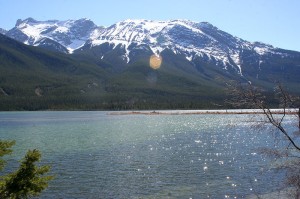
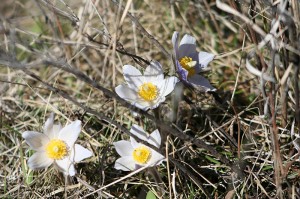

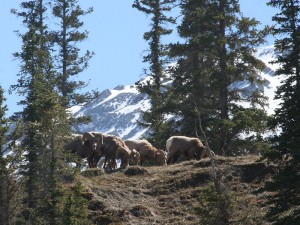

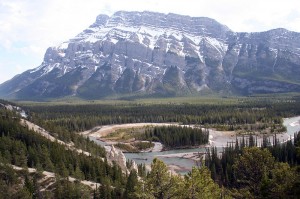
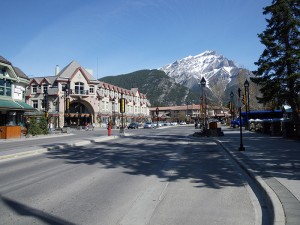
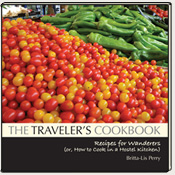
{ 1 comment… read it below or add one }
Aloha Guyz,
I’ve yet to take a picture that truly captured what I saw in person. That especially applies to our time in the Canadian Rockies. Maybe its because you see in 3-D and photos are 2-D? Indeed, Lake Louise is photogenic.
By the way, how is the Athabasca glacier doing? When Sylvia and I were there in 1986. Back then, it was just a short walk to get to the glacier from the Icefields Parkway.
Also, I remember the Canadian Park campgrounds were head and shoulders above the U. S. National Park campgrounds.
Did check out the Banff Springs Hotel. Might of had a glass of wine…really decadent-style. Too rish for us then, and I am sure that is the case now.
Keep truckin’,
Warren